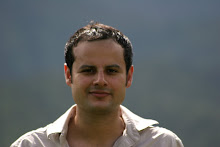
Posted By Wendy Bounds On June 13, 2008 @ 6:08 pm In Books, Women Entrepreneurs, Leadership, Marketing, Technology, Tools, Video | 41 Comments
The best entrepreneur blogs – and often the most successful ones — do more than just promote the entrepreneurs or their projects. Star power can draw attention, but it won’t sustain it if the blog doesn’’t “give.”
Give is a broad term. You can give tangible tools and information to help build a business. Or a motivational story that inspires someone to try an idea. You can give a laugh. You can give food for thought. You can give debate. You can give of yourself, and if you’re interesting enough, people will come back for more. Below, some examples of entrepreneurs who do this:
Dominate a Niche:
[1] Tom Szaky writes [2] The Eco-Capitalist, a blog about driving profits by being environmentally and socially responsible. Mr. Szaky is chief executive officer of [3] Terracycle, a company that finds creative ways to reuse waste in products like plant food, cleaners and tote bags. Recent posts include: [4] “Will Your Customers Pay to Go Green?”
Ecommerce blog [5] Get Elastic is another example. The blog shares general strategies for selling on the Internet. Recent posts include: [6] “9 Privacy Policy Usability Tips,” [7] “Cart Abandonment,” and [8] “Dads and Grads: Missed Merchandising Opportunities.”
Motivate/Inspire/Teach:
Two well-known bloggers in this category are Seth Godin and Guy Kawasaki. Mr. Godin was founder of Yoyodyne, an interactive direct-marketing company, which Yahoo Inc. acquired in late 1998. He is an author, blogger and public speaker, and his [9] marketing blog often inspires by giving broader direction in business and life. (Recent posts talk about [10] serial numbers and [11] financial advice for grads.)
Mr. Kawasaki is a managing director of [12] Garage Technology Ventures, an early-stage venture-capital firm. He’s an author and public speaker and his blog, [13] How to Change the World, also includes a link to a job board, which is a motivator. Like Godin, he often provides usable lists to readers. One example: [14] “The Top Ten Stupid Ways to Hinder Market Adoption.”
Offer Tools:
Most entrepreneur blogs do some of this, though several specialize in it. [20] WorkHappy.net by Carson McComas writes about “killer resources for entrepreneurs,” often calling out new online tools. Anita Campbell pens [21] Smallbiztrends.com with tips and strategies on issues such as business plans, picking domain names and going mobile. So does John Jantsch’s [22] Duct Tape Marketing and Drew McLellan’s [23] Drew’s Marketing Minute.
Entertain and Promote:
The best route to self-promotion is through entertainment. Holly Dunlap fuels marketing of her fashion company with a juicy, photo-laden [24] online diary chronicling her dinners, parties and, sometimes, hangovers. Justine Ezarik, a graphic/Web designer and video editor, began transmitting her life via Internet video last year and has transformed that success into multiple avenues, including her blog, [25] tastyblogsnack, where she dissects technology and entertains us.
“If You’re Interested in My Company…
…maybe you’re interested in me – or more about my company.” These blogs feed loyal customers’ desire to connect with a brand. The founders of [26] Honest Tea, Seth Goldman and Barry Nalebuff keep [27] such a blog. Craig Newmark of [28] craigslist [29] blogs regularly on anything he finds of interest ([30] finches, [31] politics and [32] “Sex and The City”).
One of the most successful examples is billionaire entrepreneur and investor Mark Cuban, owner of the [33] Dallas Mavericks. His [34] Blog Maverick waxes on everything from [35] cutting-edge technology to the [36] NFL and salary caps and gets tremendous response from readers.
A warning: Readers have typically already bought your product, so don’t just flog it; give them something new to enjoy.
This list is just a start. We want to know what entrepreneur bloggers you think are doing a great job in a particular arena. What else should people be reading—and why?
Article printed from Independent Street: http://blogs.wsj.com/independentstreet
URL to article: http://blogs.wsj.com/independentstreet/2008/06/13/15-entrepreneur-blogs-worth-reading/
URLs in this post:
[1] Tom Szaky: http://online.wsj.com/article/SB117979361996510232-search.html?KEYWORDS=Szaky&COLLECTION=wsjie/
6month
[2] The Eco-Capitalist: http://blog.inc.com/the-eco-capitalist/index.html
[3] Terracycle: http://www.terracycle.net/
[4] “Will Your Customers Pay to Go Green?”: http://blog.inc.com/the-eco-capitalist/2008/04/will_your_customers_pay_to_go_1.html#more
[5] Get Elastic: http://www.getelastic.com/
[6] “9 Privacy Policy Usability Tips,”: http://www.getelastic.com/9-privacy-policy-usability-tips/
[7] “Cart Abandonment,”: http://www.getelastic.com/cart-abandonment-nipping-fudds-in-the-bud/
[8] “Dads and Grads: Missed Merchandising Opportunities.”: http://www.getelastic.com/missed-event-marketing-opportunity/
[9] marketing blog: http://sethgodin.typepad.com/
[10] serial numbers: http://sethgodin.typepad.com/seths_blog/2008/06/serial-number-m.html
[11] financial advice for grads.: http://sethgodin.typepad.com/seths_blog/2008/06/urgent-personal.html
[12] Garage Technology Ventures: http://www.garage.com/
[13] How to Change the World: http://blog.guykawasaki.com
[14] “The Top Ten Stupid Ways to Hinder Market Adoption.”: http://blog.guykawasaki.com/2007/01/the_top_ten_stu.html
[15] Lifestream: http://kk.org/kk/
[16] Wired: http://www.wired.com/
[17] “Power of Failure”: http://kk.org/ct2/2008/06/the-power-of-failure.php
[18] Bribe Your New Employees to Quit.: http://kk.org/ct2/2008/05/bribe-your-new-employees-to-qu.php
[19] go-to blogger: http://gladwell.typepad.com/gladwellcom/
[20] WorkHappy.net : http://workhappy.net
[21] Smallbiztrends.com: http://Smallbiztrends.com
[22] Duct Tape Marketing : http://www.ducttapemarketing.com/blog/
[23] Drew’s Marketing Minute: http://Drewsmarketingminute.com
[24] online diary : http://www.hollywould.com/shop/cart.php?main&page=diary
[25] tastyblogsnack: http://tastyblogsnack.com/
[26] Honest Tea: http://honesttea.com/
[27] such a blog: http://honesttea.com/blog/index.php/category/from-seth-and-barry/
[28] craigslist: http://www.craigslist.org/about/sites.html
[29] blogs regularly : http://www.cnewmark.com
[30] finches: http://www.cnewmark.com/2008/06/colorado-finch.html
[31] politics: http://www.cnewmark.com/2008/06/mccain-getting.html
[32] “Sex and The City”: http://www.cnewmark.com/2008/06/sex-and-the-cit.html
[33] Dallas Mavericks: http://www.nba.com/mavericks/
[34] Blog Maverick: http://www.blogmaverick.com/
[35] cutting-edge technology: http://www.blogmaverick.com/2008/06/04/why-tiered-broadband-is-a-wonderful-thing-and-asivs/
[36] NFL and salary caps: http://www.blogmaverick.com/2008/05/25/understanding-salary-caps-and-why-the-nfl-opted-out/

